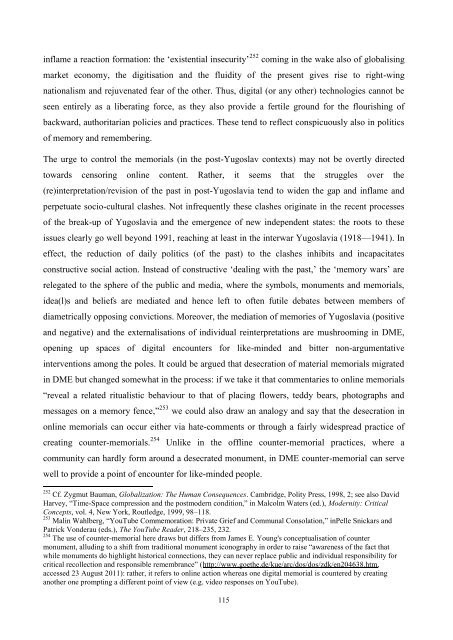UNIVERSITY OF NOVA GORICA GRADUATE SCHOOL ...
UNIVERSITY OF NOVA GORICA GRADUATE SCHOOL ...
UNIVERSITY OF NOVA GORICA GRADUATE SCHOOL ...
Create successful ePaper yourself
Turn your PDF publications into a flip-book with our unique Google optimized e-Paper software.
inflame a reaction formation: the ‗existential insecurity‘ 252 coming in the wake also of globalising<br />
market economy, the digitisation and the fluidity of the present gives rise to right-wing<br />
nationalism and rejuvenated fear of the other. Thus, digital (or any other) technologies cannot be<br />
seen entirely as a liberating force, as they also provide a fertile ground for the flourishing of<br />
backward, authoritarian policies and practices. These tend to reflect conspicuously also in politics<br />
of memory and remembering.<br />
The urge to control the memorials (in the post-Yugoslav contexts) may not be overtly directed<br />
towards censoring online content. Rather, it seems that the struggles over the<br />
(re)interpretation/revision of the past in post-Yugoslavia tend to widen the gap and inflame and<br />
perpetuate socio-cultural clashes. Not infrequently these clashes originate in the recent processes<br />
of the break-up of Yugoslavia and the emergence of new independent states: the roots to these<br />
issues clearly go well beyond 1991, reaching at least in the interwar Yugoslavia (1918—1941). In<br />
effect, the reduction of daily politics (of the past) to the clashes inhibits and incapacitates<br />
constructive social action. Instead of constructive ‗dealing with the past,‘ the ‗memory wars‘ are<br />
relegated to the sphere of the public and media, where the symbols, monuments and memorials,<br />
idea(l)s and beliefs are mediated and hence left to often futile debates between members of<br />
diametrically opposing convictions. Moreover, the mediation of memories of Yugoslavia (positive<br />
and negative) and the externalisations of individual reinterpretations are mushrooming in DME,<br />
opening up spaces of digital encounters for like-minded and bitter non-argumentative<br />
interventions among the poles. It could be argued that desecration of material memorials migrated<br />
in DME but changed somewhat in the process: if we take it that commentaries to online memorials<br />
―reveal a related ritualistic behaviour to that of placing flowers, teddy bears, photographs and<br />
messages on a memory fence,‖ 253 we could also draw an analogy and say that the desecration in<br />
online memorials can occur either via hate-comments or through a fairly widespread practice of<br />
creating counter-memorials. 254<br />
Unlike in the offline counter-memorial practices, where a<br />
community can hardly form around a desecrated monument, in DME counter-memorial can serve<br />
well to provide a point of encounter for like-minded people.<br />
252 Cf. Zygmut Bauman, Globalization: The Human Consequences. Cambridge, Polity Press, 1998, 2; see also David<br />
Harvey, ―Time-Space compression and the postmodern condition,‖ in Malcolm Waters (ed.), Modernity: Critical<br />
Concepts, vol. 4, New York, Routledge, 1999, 98–118.<br />
253 Malin Wahlberg, ―YouTube Commemoration: Private Grief and Communal Consolation,‖ inPelle Snickars and<br />
Patrick Vonderau (eds.), The YouTube Reader, 218–235, 232.<br />
254 The use of counter-memorial here draws but differs from James E. Young's conceptualisation of counter<br />
monument, alluding to a shift from traditional monument iconography in order to raise ―awareness of the fact that<br />
while monuments do highlight historical connections, they can never replace public and individual responsibility for<br />
critical recollection and responsible remembrance‖ (http://www.goethe.de/kue/arc/dos/dos/zdk/en204638.htm,<br />
accessed 23 August 2011): rather, it refers to online action whereas one digital memorial is countered by creating<br />
another one prompting a different point of view (e.g. video responses on YouTube).<br />
115

















